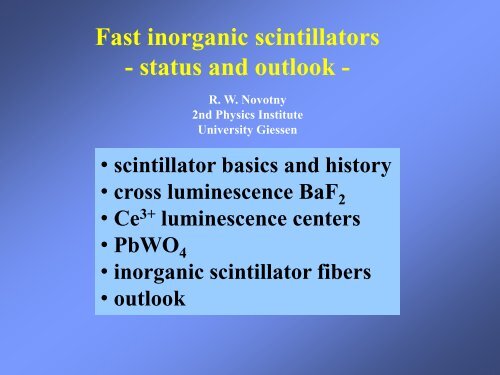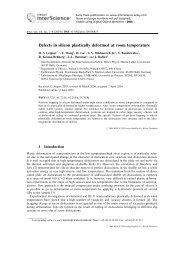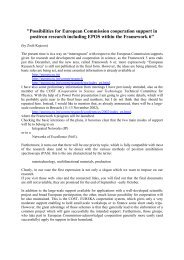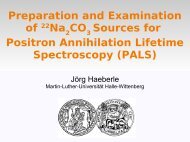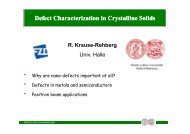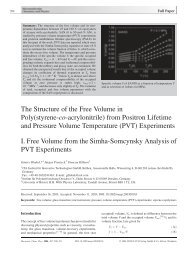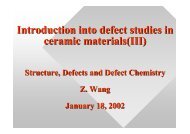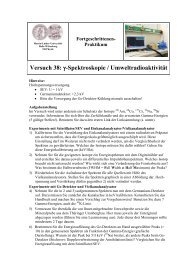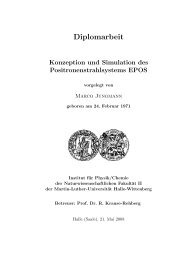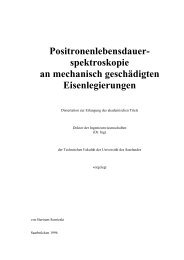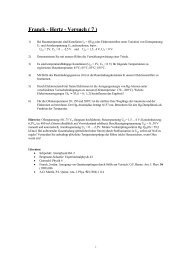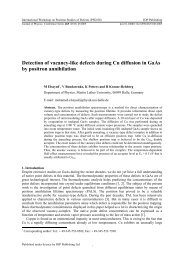Fast inorganic scintillators - Positron Annihilation in Halle
Fast inorganic scintillators - Positron Annihilation in Halle
Fast inorganic scintillators - Positron Annihilation in Halle
Create successful ePaper yourself
Turn your PDF publications into a flip-book with our unique Google optimized e-Paper software.
<strong>Fast</strong> <strong><strong>in</strong>organic</strong> <strong>sc<strong>in</strong>tillators</strong><br />
- status and outlook -<br />
R. W. Novotny<br />
2nd Physics Institute<br />
University Giessen<br />
• sc<strong>in</strong>tillator basics and history<br />
• cross lum<strong>in</strong>escence BaF 2<br />
• Ce 3+ lum<strong>in</strong>escence centers<br />
• PbWO 4<br />
• <strong><strong>in</strong>organic</strong> sc<strong>in</strong>tillator fibers<br />
• outlook
asic concept of a sc<strong>in</strong>tillation detector<br />
X rays gamma<br />
rays<br />
heavy charged<br />
particles<br />
thermal neutrons<br />
energetic neutrons<br />
Photoelectric effect<br />
Compton effect<br />
Pair production<br />
Bethe Bloch<br />
<br />
e<br />
sc<strong>in</strong>tillator<br />
nuclear reaction<br />
proton<br />
<br />
ionization<br />
excitation<br />
many<br />
e-h pairs<br />
request for a wide spectrum of detector materials
Number of dicovered <strong>sc<strong>in</strong>tillators</strong><br />
history<br />
Quantity of pr<strong>in</strong>cipal <strong><strong>in</strong>organic</strong> <strong>sc<strong>in</strong>tillators</strong><br />
discovered<br />
4<br />
3.5<br />
3<br />
2.5<br />
2<br />
1.5<br />
1<br />
0.5<br />
0<br />
<strong>in</strong>vestigation of<br />
Photomultiplier<br />
Curran / Baker<br />
X-ray imag<strong>in</strong>g<br />
screens<br />
a -scatter<strong>in</strong>g<br />
SrI 2:Eu 1968/2008<br />
LSO:Ce,Ca 2007<br />
LuI 3:Ce 2003<br />
LaBr 3:Ce 2001<br />
LYSO:Ce 2001<br />
LuYAP:Ce 2001<br />
LaCl 3:Ce 2000<br />
LuAP:Ce 1994<br />
LSO:Ce 1982<br />
1900 1910 1920 1930 1940 1950 1960 1970 1980 1990 2000<br />
Years<br />
Alcali-Halides<br />
Oxides<br />
M.Korzhik, 2003<br />
year<br />
discovery and development<br />
of new sc<strong>in</strong>tillator materials<br />
are strongly correlated with basic research and technology <strong>in</strong> physics ...<br />
M.J.Weber<br />
J. of Lum. 100 (2002) 35
<strong><strong>in</strong>organic</strong> <strong>sc<strong>in</strong>tillators</strong><br />
large variations <strong>in</strong>:<br />
• compactness<br />
• lum<strong>in</strong>escence yield<br />
volume: 1X 0 3<br />
pulse height / mV<br />
time / ns
asic processes lum<strong>in</strong>escence center<br />
basic processes <strong>in</strong><br />
<strong><strong>in</strong>organic</strong> sc<strong>in</strong>tillator<br />
ionic crystal<br />
host material<br />
E gap > ~ 4 - 12 eV<br />
e<br />
h<br />
thermalization<br />
lum<strong>in</strong>escence centre<br />
<strong>in</strong>tr<strong>in</strong>sic or<br />
dopant<br />
transport<br />
conduction band<br />
lum<strong>in</strong>escence<br />
valence band
… but it is more complex !<br />
e<br />
h<br />
thermalization<br />
1 - 100 ps<br />
Trap<br />
radiationless<br />
recomb<strong>in</strong>ation<br />
thermalization<br />
thermally released<br />
Shallow trap<br />
fast to slow<br />
(afterglow)<br />
Defect<br />
transfer or<br />
lum<strong>in</strong>escence<br />
estimation of achievable light yield:<br />
conduction band<br />
Y<br />
direct excitation<br />
relaxation<br />
LC<br />
valence band<br />
> ns<br />
E<br />
<br />
E<br />
lum<strong>in</strong>escence<br />
<br />
gap<br />
S<br />
Q
<strong>in</strong>terplay of excitation and emission …<br />
… and optical transparency of the material
achievable energy resolution<br />
can be further optimized by match<strong>in</strong>g to photo sensor
most <strong>sc<strong>in</strong>tillators</strong> are sensitive to temperature<br />
thermal quench<strong>in</strong>g !
achievable energy resolution not only determ<strong>in</strong>ed by<br />
photon statistics !?<br />
but:<br />
resolution at 662 keV / %<br />
10<br />
8<br />
6<br />
4<br />
2<br />
BaF 2 BGO<br />
YAlO 3 :Ce<br />
Lu 3 Al 4 O 12 :Pr<br />
LSO:Ce<br />
CsI:Tl<br />
NaI:Tl<br />
LaCl 3<br />
R stat<br />
LaBr 3<br />
SrI 2 :Eu<br />
0<br />
0 5.000 10.000 15.000 20.000<br />
number of detected photons at 662 keV<br />
l<strong>in</strong>ear response of the sc<strong>in</strong>tillator, <strong>in</strong>dex of refraction, light<br />
collection, quantum efficiency and l<strong>in</strong>earity of sensor, etc.
non-proportionality<br />
and<br />
energy resolution<br />
typical examples<br />
Relative light yield<br />
Energy reslution at FWHM (%)<br />
1.2<br />
1.1<br />
1.0<br />
0.9<br />
10<br />
LaBr 3:Ce<br />
NaI:Tl<br />
10 100 1000<br />
Energy (keV)
how everyth<strong>in</strong>g started: R.Hofstadter, Phys.Rev. 74 (1948) 100<br />
NaI<br />
with source<br />
NaI<br />
without source
BaF 2<br />
k<strong>in</strong>etics of the two fast<br />
sc<strong>in</strong>tillation components<br />
at l 195nm and l 220nm<br />
ideal for fast tim<strong>in</strong>g:<br />
• fast rise time<br />
• fast decay time<br />
• sufficient light yield<br />
tim<strong>in</strong>g determ<strong>in</strong>ed by arrival of<br />
first photons at sensor<br />
P.Schotanus et al., NIM A259 (1987) 586
fast slow component<br />
BaF 2<br />
both lum<strong>in</strong>escence components show a<br />
different temperature dependence<br />
different sc<strong>in</strong>tillation<br />
mechanisms<br />
slow component:<br />
strongly temperature dependent<br />
determ<strong>in</strong>es energy resolution<br />
dY/dT-1.4%/ 0 K
BaF 2: fast UV lum<strong>in</strong>escence<br />
E gap<br />
E VOC<br />
fast<br />
STE<br />
CondB<br />
ValB<br />
Core-Valence<br />
Lum<strong>in</strong>escence CVL<br />
OCoreB<br />
Yu.M. Aleksandrov et al, Sov. Phys. Sol. State 26 (1984) 1734<br />
6s, 5d Ba 2+<br />
2p F -<br />
5p Ba 2+<br />
Ionic crystal<br />
E VOC < E gap<br />
Auger-free lum<strong>in</strong>escence<br />
Cross lum<strong>in</strong>escence
• identification via pulse shape analysis PSA<br />
due to <strong>in</strong>tr<strong>in</strong>sic lum<strong>in</strong>escence properties:<br />
sc<strong>in</strong>tillation components show different response to<br />
electromagnetic or hadronic probes CsI(Tl), BaF 2, ...<br />
proton<br />
photon<br />
fast component<br />
time<br />
total light output<br />
signal <strong>in</strong>tegration width<br />
plastic<br />
VETO<br />
E-fast E-fast<br />
BaF 2-detector<br />
photons photons<br />
protons protons<br />
E-total<br />
identification of charged<br />
and neutral events
time-of-flight / ns<br />
particle ID:<br />
• time-of-flight<br />
BaF 2 (TAPS)<br />
2 AGeV Ca+Ca<br />
energy / MeV<br />
E (MeV)<br />
250<br />
200<br />
150<br />
100<br />
50<br />
0<br />
C <br />
0<br />
X ...<br />
0 2 4 6 8 10<br />
t (ns)<br />
time resolution: s t > 85 ps
Time-of-flight PET<br />
detector concept<br />
achieved position resolution<br />
S.Tavernier et al., BaF 2 with MWPC-TMAE readout
TAPS<br />
511 modules<br />
counts<br />
A2@MAMI<br />
Ma<strong>in</strong>z<br />
tagged photon<br />
facility<br />
E < 1.5GeV<br />
on-l<strong>in</strong>e data<br />
<br />
<strong>in</strong>variant mass / MeV<br />
complete<br />
new readout
CVL candidates<br />
E gap 4 - 13 eV<br />
Condition for CVL<br />
E VOC < E gap<br />
Ca 2+<br />
P.A. Rodnyi, Sov. Phys. Solid State 34(1992)1053<br />
I<br />
Br<br />
Cl<br />
F<br />
E VOC<br />
Sr 2+<br />
C.W.E. van Eijk, Nucl. Tracks. Radiat. Meas. 21(1993)5<br />
CVL<br />
17 eV 13 eV 8 eV 10 eV 7.5 eV 4.5 eV<br />
Rb +<br />
Ba2+ Rb<br />
K + +<br />
Ba2+ K +<br />
decay time ~ 1 ns<br />
Cs + Cs +<br />
F, Cl, Br, I<br />
CondB<br />
ValB<br />
OCoreB<br />
light yield 2000 photons/MeV
Ce 3+ lum<strong>in</strong>escence center<br />
Core +<br />
1 electron <strong>in</strong><br />
4f state<br />
e<br />
excitation<br />
h<br />
Ce 3+<br />
relaxation<br />
conduction band<br />
5d<br />
4f<br />
emission<br />
valence band<br />
5d 4f allowed dipole transition<br />
fast response ~ 20 ns
Ce 3+ lum<strong>in</strong>escence center<br />
Ce 3+ relaxation Stokes shift<br />
energy<br />
0.1 fs<br />
1 ps<br />
quench<strong>in</strong>g<br />
> ns<br />
configuration coord<strong>in</strong>ate<br />
4f levels shielded<br />
no l<strong>in</strong>e broaden<strong>in</strong>g<br />
Rodnyi<br />
Intensity (arb. units)<br />
C3h<br />
5.10 eV<br />
4.96 eV<br />
4.71 eV<br />
4.52 eV<br />
4.41 eV<br />
Exc.<br />
6.2 eV<br />
5d<br />
S=5900 cm -1<br />
<br />
150 200 250 300 350 400 450<br />
Wavelength (nm)<br />
4f<br />
LaCl 3:0.57%Ce<br />
3.68 eV<br />
3.46 eV<br />
1740 cm -1<br />
broad<br />
emission l<strong>in</strong>es<br />
C. van Eijk
additional candidates<br />
ion ground state notation excited state<br />
La 3+ Xe configuration<br />
(closed shell)<br />
Ce 3+ ,, + 1 4f electron 4f 1 4f 0 5d 1<br />
Pr 3+ ,, + 2 4f electrons 4f 2 4f 1 5d 1<br />
Nd 3+ ,, + 3 4f electrons 4f 3 4f 2 5d 1<br />
…<br />
Eu 2+ (half filled shell) + 7 4f electrons 4f 7 4f 6 5d 1<br />
Gd 3+ (half filled shell) 4f 7<br />
…<br />
Lu 3+ (closed shell) + 14 4f electrons 4f 14
fast sc<strong>in</strong>tillation mechanism<br />
Ce 3+ 5d 4f<br />
<strong>in</strong> favourable host<br />
Y<br />
<br />
E<br />
<br />
E<br />
Egap LY<br />
Egap l<br />
gap<br />
~ 20 ns<br />
S<br />
Q<br />
match<strong>in</strong>g light sensor<br />
tim<strong>in</strong>g properties:<br />
<br />
<br />
<br />
1<br />
<br />
<br />
E [eV]<br />
n<br />
l<br />
3<br />
12<br />
10<br />
8<br />
6<br />
4<br />
2<br />
0<br />
see papers by P. Dorenbos<br />
Ce 3+ levels and Egap<br />
free ion<br />
2 n <br />
<br />
<br />
<br />
3<br />
fluorides<br />
chlorides<br />
2 <br />
<br />
<br />
<br />
bromides<br />
2<br />
iodides<br />
<br />
5d<br />
oxides<br />
E gap<br />
Ce 3+ E 5d-4f<br />
sulfides<br />
<br />
selenides<br />
4f<br />
2
K 2LaX 5:0.7% Ce 3+ (X = Cl, Br, I)<br />
sc<strong>in</strong>tillation decay<br />
lifetime from Cl to Br to I<br />
emission<br />
wavelength from Cl to Br to I
LaCl 3:Ce 3+ sc<strong>in</strong>tillation decay<br />
Intensity (a.u.)<br />
25 ns<br />
10% LaCl3 :Ce 3+<br />
30%<br />
LSO<br />
NaI:Tl<br />
0 200 400<br />
Time (ns)<br />
600 800 1000<br />
NaI:Tl<br />
230 ns<br />
Lu 2SiO 5:Ce<br />
40 ns
LaCl 3:Ce 3+ energy resolution<br />
Intensity (a.u.)<br />
55 Fe<br />
R=42%<br />
0 5 10<br />
241 Am<br />
R=10.5%<br />
50<br />
Energy (keV)<br />
E.V.D. van Loef, P. Dorenbos, C.W.E. van Eijk, K.W. Krämer, H.U. Güdel<br />
Appl. Phys. Lett. 77 (2000) 1467<br />
100<br />
137 Cs<br />
500<br />
R=3.3%<br />
800<br />
50,000<br />
photons/MeV<br />
NaI:Tl<br />
40,000<br />
photons/MeV<br />
Lu 2SiO 5:Ce<br />
26,000<br />
photons/MeV
LaCl 3:Ce 3+<br />
4“ x 6“<br />
4 x 6 mm 2<br />
Counts<br />
32keV Ba<br />
400 500 600 700 800<br />
La X-ray escape peak<br />
0 200 400 600 800<br />
Energy (keV)<br />
E/E=4.1%<br />
E/E=3.1%<br />
E.V.D. van Loef, P. Dorenbos, C.W.E. van Eijk,<br />
K. W. Krämer, H.U. Güdel,<br />
Appl. Phys. Lett. 77 (10) (2000) 1467.
LaBr 3: 5%Ce 3+<br />
counts (arb. units)<br />
1.2<br />
1.0<br />
0.8<br />
0.6<br />
0.4<br />
0.2<br />
61,000 ph/MeV<br />
R=2.9%<br />
0.0<br />
0 100 200 300 400 500 600 700 800<br />
380<br />
Pulse height spectrum 662 keV gamma rays<br />
NaI:Tl<br />
2.8 % FWHM<br />
6.5 % FWHM<br />
energy (keV)<br />
energy resolution<br />
light yield<br />
70,000 photons/MeV<br />
(NaI:Tl 40,000 ph/MeV)<br />
decay time<br />
16 ns<br />
(NaI:Tl 230 ns)<br />
E.V.D. van Loef, P. Dorenbos, C.W.E. van Eijk, K.W. Krämer,<br />
H.U. Güdel<br />
Appl Phys Lett 79(2001)1573
LaBr 3:Ce 3+ decay time and time resolution<br />
<strong>in</strong>tensity, normalized<br />
10 0<br />
10 -1<br />
10 -2<br />
10 -3<br />
decay time 16 ns<br />
rise time faster<br />
0 50 100 150 200 250<br />
time, ns<br />
0.5%<br />
5%<br />
10%<br />
20 %<br />
30%<br />
511 keV - 511 keV<br />
t < 300ps<br />
courtesy Kanai Shah, RMD
LaBr 3:Ce 3+<br />
345 cm 3 volume<br />
380<br />
Counts<br />
6000<br />
5000<br />
4000<br />
3000<br />
2000<br />
1000<br />
BrilLanCe 380 3x3<br />
137 Cs<br />
FWHM<br />
3.00%<br />
0<br />
0 200 400 600 800 1000<br />
channel
Lanthanum halides:<br />
X-ray excited optical lum<strong>in</strong>escence<br />
LaCl 3:Ce 3+<br />
• Ce concentration , light yield <br />
• Ce concentration , host emission <br />
LaBr 3:Ce 3+<br />
• Ce concentration , light yield
some sc<strong>in</strong>tillator specs<br />
Density<br />
g/cm 3<br />
Attenuation<br />
length at<br />
511 keV<br />
mm<br />
Photoel<br />
effect<br />
%<br />
Light yield<br />
phot/MeV<br />
Decay time<br />
ns<br />
Emission<br />
max<br />
NaI:Tl 3.67 29.1 17 41,000 230 410<br />
Bi 4Ge 3O 12 (BGO) 7.1 10.4 40 9,000 300 480<br />
Lu 2SiO 5:Ce (LSO) 7.4 11.4 32 26,000 40 420<br />
Lu 2(1-x)Y 2xSiO 5:Ce (LYSO)<br />
X = 0.1<br />
7.1 12 30,000 40 420<br />
LuAlO 3:Ce (LuAP) 8.3 10.5 30 11,000 18 365<br />
Lu xY 1-xAlO 3:Ce (LuYAP)<br />
X = 0.2<br />
LaCl 3:Ce 3.86 28.0 14.7 46,000 25 (65%) 350<br />
LaBr 3:Ce 5.07 22.3 13.1 70,000 16 (97%) 380<br />
LuI 3:Ce 5.6 18.2 28 90,000 6-140 (72%) 472, 535<br />
new generation of dense, bright and radiation hard <strong>sc<strong>in</strong>tillators</strong><br />
nm
PbWO 4: a fast sc<strong>in</strong>tillator - but with low light yield<br />
counts<br />
Counts<br />
100000<br />
10000<br />
1000<br />
100<br />
10<br />
1<br />
10000<br />
8000<br />
6000<br />
4000<br />
2000<br />
T = +6 0 C<br />
Improved PWO crystal<br />
0 100 200 300 400 500 600 700 800 900<br />
T = -7 0 C<br />
time, ns<br />
T = -22 0 C<br />
T = -30 0 C<br />
0<br />
100 200 300 400 500 600 700 800<br />
light yield / a.u.<br />
t1= 6.5 ns D1= 97%<br />
t2= 30.4 ns D2= 3%<br />
60Co<br />
strong temperature quench<strong>in</strong>g<br />
counts<br />
counts<br />
3000<br />
2500<br />
2000<br />
1500<br />
1000<br />
500<br />
0<br />
3000<br />
2000<br />
1000<br />
0<br />
200 400 600 800 1000<br />
light yield / a.u.<br />
137 Cs<br />
s/E=14,5%<br />
s/E=16.9%<br />
200 400 600 800 1000<br />
light yield / a.u.<br />
22 Na<br />
s/E=10.9%
E, cm -1<br />
PbWO 4: a fast sc<strong>in</strong>tillator - but with low light yield<br />
3T 3<br />
1, T2<br />
WO 4 2-<br />
3.9 eV 3 eV<br />
1 A1<br />
Energy levels of dop<strong>in</strong>gs<br />
Donor<br />
R<br />
Acceptor<br />
doped PWO:Y, La,Mo<br />
the shallow WO 4 3- + La centre is an<br />
additional radiat<strong>in</strong>g centre<br />
prevents e - to be trapped by deep<br />
Mo centres<br />
suppresses afterglow and large part<br />
of slow components<br />
pure PbWO 4<br />
non radiative losses <strong>in</strong> PWO<br />
temperature quench<strong>in</strong>g<br />
of WO 4 2- lum<strong>in</strong>escence<br />
WO 4 2-<br />
3.9 eV 3 eV<br />
1 A1<br />
e -<br />
0.2 eV<br />
1 A1<br />
WO 4 3- +La<br />
3 eV<br />
1 A1<br />
MoO 4 3-<br />
2.5 eV
device crystal modules<br />
CMS<br />
ECAL<br />
E <br />
s<br />
10 3<br />
depth<br />
X 0<br />
photosensor B<br />
T<br />
where beam energy<br />
PbWO 4 82 26 APD/VPT 4 LHC 7<br />
0.<br />
5%<br />
@120GeV<br />
TeV
the PANDA detector at FAIR<br />
• photon detection with high resolution<br />
over a large dynamic range:<br />
10MeV < E < 15GeV<br />
• high count-rate capability (2∙107 barrel<br />
~11.000<br />
<strong>Annihilation</strong>s/s)<br />
• nearly 4 coverage<br />
• sufficient radiation hardness endcaps<br />
• tim<strong>in</strong>g <strong>in</strong>formation for trigger-less DAQ ~4.000 concept<br />
Target Spectrometer<br />
PWO-II<br />
200mm (23X o)<br />
crystals<br />
4 detector for spectroscopy and reaction dynamics with antiproton
the Target Spectrometer:<br />
based on high-quality PWO-II
optical transmission light yield @RT<br />
radiation<br />
hardness
prototype performance<br />
extension<br />
response<br />
to<br />
to<br />
energies<br />
high energy<br />
< 50MeV<br />
photons<br />
@ MaxLab<br />
energy resolution s <br />
tagged photon<br />
facility<br />
@ MAMI, Ma<strong>in</strong>z<br />
E= 26 MeV<br />
e -<br />
‘s<br />
64 MeV < E 1.5 GeV<br />
E =43.3MeV<br />
readout with <strong>in</strong>cident energy / GeV<br />
photomultiplier<br />
• optimized light output: PWO-II<br />
• cool<strong>in</strong>g: operation at T=-25 o C<br />
readout with<br />
photomultiplier
eadout via SADC: further improvement<br />
time resolution<br />
1 ns<br />
energy-resolution<br />
( 3x3 matrix )
consequences of cool<strong>in</strong>g:<br />
• fast decay k<strong>in</strong>etics even at T=-25 o C<br />
LY(100ns)/LY(1µs) > 0.9<br />
• constant ratio<br />
LY(-25 o C)/LY(+18 o C) = 3.9<br />
•„no“ recovery of radiation damage at T=-25 o C<br />
asymptotic light loss correlated with k (RT)<br />
T= -25°C<br />
rel. light loss @ 25 o C / %<br />
k @ RT / m -1
ecovery of radiation damage @RT<br />
∆k (420 nm) / m -1<br />
1,0<br />
0,9<br />
0,8<br />
0,7<br />
0,6<br />
0,5<br />
0,4<br />
0,3<br />
0,2<br />
0,1<br />
0,0<br />
@RT<br />
0 50 100 150 200<br />
illum<strong>in</strong>ation time / m<strong>in</strong><br />
Spontaneous<br />
LED_1550nm<br />
LED_1300nm<br />
LED_1060nm<br />
LED_940nm<br />
LED_464nm<br />
0 200 400 600 800 1000 1200 1400 1600<br />
applied <strong>in</strong>tegral dose of 60 Co: D = 30Gy<br />
recovery of normalized light yield / %<br />
100<br />
90<br />
80<br />
70<br />
60<br />
50<br />
@T= -25 o C<br />
illum<strong>in</strong>ation time / m<strong>in</strong><br />
470 nm<br />
525 nm<br />
640 nm<br />
840 nm<br />
935 nm
technology: micro-pull<strong>in</strong>g-down technique (µPD)
material density<br />
LuAG<br />
:Ce<br />
g/cm 3<br />
Lu 3Al 5O 12:Ce 3+<br />
Z eff<br />
emission<br />
wavelength<br />
nm<br />
<strong>in</strong>dex of<br />
refraction<br />
decay<br />
time<br />
ns<br />
light<br />
Yield<br />
ph/MeV<br />
6.7 63 530 1.84 50-100 15.000<br />
emission spectra at various<br />
positions: slight changes<br />
tested fibers: 0.45mm - 2.0mm
esponse to 241 Am - s<strong>in</strong>gle sided readout<br />
Ø 1.0 mm fiber<br />
~<br />
e<br />
-μd<br />
LuAG:Ce<br />
additional wrapp<strong>in</strong>g with teflon <strong>in</strong>creases the light yield by ≈ 70 %
esponse to 241 Am - co<strong>in</strong>cidence readout<br />
fiberlength between 2.5 cm and 4.5 cm<br />
time resolution of a s<strong>in</strong>gle PMT:<br />
(deduced from left - right co<strong>in</strong>cidence)<br />
σ Δt<br />
t <br />
2<br />
LuAG:Ce
improvement of technology<br />
• efficiency<br />
• reproducibility<br />
• multi-pull<strong>in</strong>g<br />
• packag<strong>in</strong>g<br />
simultaneous growth of<br />
7 LuAG fibers<br />
100 mm<br />
20 fibers of<br />
comparable quality<br />
LuAG:Ce
material density<br />
g/cm 3<br />
Z eff<br />
emission<br />
wavelength<br />
nm<br />
<strong>in</strong>dex of<br />
refraction<br />
decay<br />
time<br />
ns<br />
light<br />
Yield<br />
ph/MeV<br />
LYSO 7.4 66 420 1.81 40 27.000<br />
Lu 2(1-x)Y 2xSiO 5:Ce 3+ tested fibers: 0.6mm - 2.0mm<br />
emission spectra: Ø 0.6mm<br />
- nearly constant emission<br />
- severe attenuation
LYSO:Ce fiber (Ø = 0.3 mm, L = 100 mm)<br />
response to 241 Am - s<strong>in</strong>gle sided readout<br />
average attenuation coefficient:<br />
μ ≈ (0.68 ± 0.02) cm -1<br />
LuAG:Ce (Ø 0.3 mm): μ ≈ (0.85 ± 0.06) cm -1<br />
μ<br />
<br />
μ <br />
0.68<br />
0.018<br />
cm<br />
-1<br />
cm<br />
-1<br />
LYSO:Ce<br />
good homogeneity<br />
of all <strong>in</strong>vestigated fibers
LuAG:Ce fibers<br />
100 mm long<br />
1 mm diameter<br />
round
SiPM readout – PET application<br />
KVI<br />
Hamamatsu MPPC S10362-33-100C<br />
60 Co source placed close to fiber<br />
at position A B<br />
SiPM<br />
fiber bundle of 5 LuAG:Ce<br />
MPPC preamplifier (KVI development)<br />
LuAG:Ce<br />
close-up:<br />
fibers coupled to SiPM
contact established with Russian fiber developer<br />
jo<strong>in</strong>t activity with WP28 SiPM<br />
laboratory <strong>in</strong> Chernogolovka
Thanks for your attention
energy resolution - example: NaI:Tl<br />
ΔE/E<br />
(%)<br />
100<br />
40<br />
20<br />
10<br />
4<br />
2<br />
1<br />
2.<br />
35<br />
Nel<br />
R sci<br />
Non prop<br />
4 10 20 40 100 200 400 1000<br />
E / keV<br />
schematic
• identification via<br />
pulse shape analysis PSA<br />
reaction products:<br />
2 AGeV Ar + Ca<br />
charged<br />
events<br />
protons<br />
all events<br />
photons<br />
neutral<br />
events<br />
n
• identification via pulse shape analysis PSA<br />
radius / MeV<br />
visualisation of PSA <strong>in</strong> polar coord<strong>in</strong>ates<br />
protons<br />
+<br />
photons<br />
angle / °<br />
transformation:<br />
radius<br />
<br />
short<br />
2<br />
long<br />
2<br />
,<br />
short<br />
angle a tan( )<br />
long
Ce 3+ lum<strong>in</strong>escence center<br />
5d – 4f energy difference<br />
5d level<br />
5d bands<br />
4f levels<br />
5d bands<br />
4f levels<br />
Ce3+ Pr3+ Nd 3+ Ce3+ Pr3+ Nd 3+<br />
free Ce3+ ion<br />
<strong>in</strong> crystal<br />
Ce 3+ 5d-4f level distance<br />
<strong>in</strong> crystal<br />
• 5d level shifts down<br />
• bands<br />
• split by crystal field<br />
• 4f levels hardly affected<br />
the lowest 5d-band edge matters<br />
C. van Eijk
additional candidates<br />
Ce, Pr, Nd 5d-4f transitions - ions <strong>in</strong> crystal field<br />
5d bands<br />
Ce 3+ Pr 3+ Nd 3+<br />
The lowest<br />
5d-band edge<br />
matters<br />
4f levels<br />
Radiolum<strong>in</strong>escence spectra of 0.5 % Ce 3+ -doped and Pr 3+ -doped<br />
Ca 3(BO 3) 2 s<strong>in</strong>gle crystals under 241Am 5.5 MeV α-ray.<br />
Y. Fujimoto et al, 2010 IEEE NSS Conf. Rec., pp. 192-194.<br />
Intensity [arb.units]<br />
Wavelength [nm]<br />
X-ray <strong>in</strong>duced emission spectrum of LaF 3:Nd.<br />
C.W.E. van Eijk et al, IEEE Trans. Nucl. Sci., 41, pp. 738-741, 1994.
Ce 3+ energy level shifts<br />
E [eV]<br />
12<br />
10<br />
8<br />
6<br />
4<br />
2<br />
0<br />
free ion<br />
fluorides<br />
chlorides<br />
bromides<br />
iodides<br />
oxides<br />
E gap<br />
Ce 3+ E 5d-4f<br />
sulfides<br />
selenides
comparison of a 1.0 mm and a 0.3 mm fiber<br />
LuAG:Ce<br />
average attenuation coefficient for Ø = 1.0 mm fibers: μ ≈ (1.56 ± 0.32) cm -1<br />
1 mm<br />
Ø<br />
Ø = 1.0 mm fiber<br />
Ø = 0.3 mm fibers: μ ≈ (0.85 ± 0.06) cm -1
improvement of technology<br />
special bundle<br />
LuAG:Ce
improvement of technology<br />
• new Iridium crucible with square nozzle<br />
fiber with quadratic cross section<br />
+ improved packag<strong>in</strong>g<br />
+ cost efficient<br />
830µm<br />
940µm<br />
LYSO:Ce
improvement of technology<br />
LYSO:Ce<br />
• new geometry of the seed:<br />
longer size decreases the longitud<strong>in</strong>al thermal gradient<br />
• reduced growth speed favors crystallization of monocl<strong>in</strong>ic<br />
crystal structures like LYSO<br />
• operat<strong>in</strong>g <strong>in</strong> oxidiz<strong>in</strong>g atmosphere<br />
• better thermal <strong>in</strong>sulation<br />
reduction of macroscopic cracks<br />
quadratic LYSO fiber


